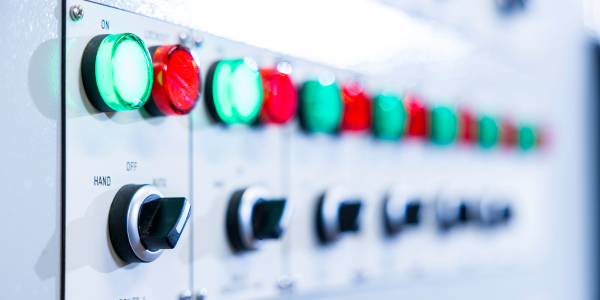If you manage a commercial building, you’re expected to meet rising standards for energy use, safety, comfort and compliance. But how do all the systems behind the scenes stay coordinated and how can you improve control without adding complexity?
That’s where BMS control panels come in. These panels house the hardware that connects building systems like HVAC, lighting and fire safety to the wider BMS. They automate local equipment control and allow smarter performance at system level.
This blog explains what a BMS control panel is, how it works, what benefits it offers and what to consider when specifying or upgrading one.
If you’re planning upgrades, facing compliance pressures or reviewing system performance, now is the time to assess your control infrastructure. Contact Cube Controls for independent advice on specifying or replacing BMS control panels.
What is a BMS Control Panel?
A BMS control panel is a wired enclosure containing the components needed to automate building services locally. In simple terms, it’s the box that lets the building run itself safely and efficiently.
Each panel typically manages a zone or system, such as an air handling unit or lighting group. It includes a programmable controller that receives inputs from sensors and sends control signals to field devices such as actuators (which move or adjust mechanical components) and relays (which switch electrical circuits on or off).
The panel is one part of the larger building management system, but it’s where much of the equipment-level control physically happens.
How Does a BMS Control Panel Work?
A BMS control panel works by receiving data from connected sensors, processing that information using pre-programmed control logic and sending commands to local building equipment. It operates as a local automation unit, handling real-time control for a specific area or system within a larger building management setup.
What Does a BMS Control Panel Actually Do?
It carries out specific control actions based on live inputs.
For example, a panel might:
- Open or close a valve based on room temperature
- Start a fan if air quality drops
- Switch off lighting in an unoccupied zone
- Regulate pump speed based on system pressure
- Provide the correct electrical power supplies for the field equipment
These actions are triggered by the programmable controller inside the panel. It sends output signals to the actuators and relays, allowing equipment to respond automatically without manual intervention.
What’s Inside a BMS Control Panel?
BMS panels include all the hardware needed to handle inputs, process logic and deliver control outputs.
A typical BMS control panel contains:
- Programmable controller, Programmable Logic Controller (PLC) or Direct Digital Controller (DDC) unit that runs pre-set control logic
- Sensors, monitor specific conditions, such as temperature or occupancy, and send that data to the controller to inform system responses
- Actuators, receive signals from the controller and physically adjust building systems to achieve the desired conditions
- Power supplies and distribution, provide regulated low-voltage power to the controller and connected devices, as well as field going power supplies to power the plant items.
- Terminal blocks, enable structured, accessible wiring connections within the panel
- Isolators / local control switches, allow safe isolation of panel power during servicing
- Network communication modules, connect the panel to the wider BMS using protocols such as BACnet or Modbus
- Wiring labels and documentation, support identification, fault tracing and maintenance with clear terminal labelling and schematics
Well-built panels improve service access, reduce error and make future upgrades easier.
Why BMS Panels Are the Nerve Centre of Smart Building Management
Building management system control panels are the point where digital building management becomes physical action. They take instructions based on programmed logic and directly control the equipment that keeps the building running.
Each panel:
- Processes local sensor inputs and executes real-time control without relying on the central interface
- Communicates directly with key systems such as HVAC, pumps, fans and dampers
- Interfaces with actuators and relays to adjust temperature, airflow, lighting and more
- Connects these local systems to the wider BMS for coordination and monitoring
While the head-end system (the central interface used for scheduling, monitoring and reporting) provides scheduling, dashboards and alarms, it’s the panels that operate the plant, i.e. the core building services like heating, ventilation and cooling equipment.
Without the panels, the BMS can’t act. That’s why they are the functional nerve centre of a smart building management system.
What Are the Main Benefits for Facilities Managers?
Well-designed panels cut running costs while simplifying maintenance and fault resolution.
Benefits include:
- Energy savings: equipment operates only when needed
- Smarter control: logic responds to real-time conditions
- Reduced call-outs: issues addressed by automation, not manual resets
- Simplified servicing: labelled wiring and consistent layouts
- Scalable upgrades: panels can accommodate future needs
For facilities teams, accessible, well-labelled panels reduce disruption and help resolve faults more quickly.
How Do BMS Panels Support UK Regulations?
BMS Panels support buildings in meeting compliance standards and regulations by enabling energy-saving control and efficient system management.
In the UK, buildings must comply with:
- Part L of the Building Regulations: energy efficiency for new and existing non-domestic buildings
- Streamlined Energy and Carbon Reporting (SECR): mandatory energy reporting for qualifying companies
- Energy Savings Opportunity Scheme (ESOS): regular energy audits
- Net Zero commitments: reducing emissions across estates by 2050
BMS panels help by enabling the control strategies that support compliance, efficiency and operational consistency across key building systems. This includes:
- Automating energy-saving behaviours
- Logging accurate usage data for reporting
- Integrating smart metering
- Supporting load control and demand reduction
These capabilities help facilities teams meet reporting requirements without adding to the day-to-day workload.
What Should I Look For in a BMS Control Panel?
Choose a panel that fits your site, not just your budget. Before specifying or upgrading, consider:
- System compatibility: can it connect to your current HVAC, lighting and metering systems?
- Wiring and layout: are terminal points clearly labelled and easy to access?
- Build quality: are components commercial-grade and rated for your environment?
- Future readiness: can you add new systems or zones later?
- Support and documentation: is everything clearly documented for engineers and site staff?
- Compliance: is the panel built to relevant British Standards and specifically BS EN 61439 guidance?
Choosing a low-cost, generic panel at the specification stage often leads to hidden costs later during servicing, maintenance or future system upgrades.
Cube Controls’ View
At Cube Controls, we have seen the long-term impact of poor panel design. Underspecified or generic panels lead to reliability issues, difficult maintenance and limited system flexibility.
“The panel is where it all comes together. If it’s not designed with the building and users in mind, you’ll face issues with reliability, servicing or integration. That’s why we tailor each one to the project.”
– Tony Williams, Director & Founder of Cube Controls.
If you’re reviewing your setup or planning a new installation, we can help. We design and install panels to suit the building layout, system requirements and long-term servicing needs. Every panel is fully tested, clearly labelled and supplied with detailed documentation to support commissioning and maintenance.
We’ve worked with facilities teams, consultants and contractors across commercial, healthcare, education and industrial environments, helping ensure BMS integration is reliable from day one. Contact Cube Controls to talk about your BMS panels.
Why BMS Control Panels Deserve Closer Attention
BMS control panels are critical to how a building operates day to day. When poorly designed or undermaintained, they become a bottleneck, limiting performance, increasing service costs and undermining system reliability. Reviewing panel design is a practical step toward improving efficiency, compliance and future readiness.
FAQs about BMS Control Panels
Do I need to replace the whole BMS to upgrade a control panel?
No. In many cases, individual panels can be upgraded or replaced without changing the entire BMS. This is often the most cost-effective way to improve system performance, particularly if the existing BMS software is still supported.
What standards should a BMS control panel comply with?
In the UK, panels should be built in line with BS EN 61439 for low-voltage switchgear and control gear assemblies. Compliance ensures electrical safety, consistent quality and easier maintenance.
Can a BMS control panel be customised for my building?
Yes. Control panels should be tailored to the building layout, system requirements and long-term servicing needs. A well-designed panel improves reliability, simplifies maintenance and ensures compatibility with your existing infrastructure.
Cube Controls is an established and experienced supplier of Building Management Systems, specialising in the design and set up of bespoke environmental and energy control programmes for commercial buildings and property.
To find out how Cube Controls can support you at all stages of design and consultancy, installation and modification and maintenance of your building management systems contact our expert and friendly team on 01903 694279 or sales@cubecontrols.co.uk.




